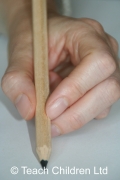Foundation Stage Pencil Grip Development
Foundation Stage (4 - 5 year olds)
There are 5 pencil grip developmental stages that a child needs to go through before they can successfully use a mature/dynamic tripod grip. They need to work through each stage and as their hand, shoulder and arm strength and mobility increases so does the ability to move to the next developmental stage of the grip.
There are principles of development called "big to small" and "proximal to distal" - basically this means that children develop the larger muscles of the trunk and arms before the smaller muscles of the hands and that the proximal muscles closer to the body centre (shoulder muscles, upper arm muscles) develop before the distal muscles which are further away (hand muscles).
The Tripod Pencil Grip is considered the most appropriate grip for handwriting, for both right and left-handed writers. This is because it allows the fingers and wrist to move freely without putting strain on the hand, helping to improve correct letter formation ability and making handwriting a more comfortable experience.
Foundation Stage (4 - 5 year olds)
When children start in Foundation Stage (4 - 5 year olds) they will be at different pencil grip development stages, this is what we would normally expect:
- A few children will be at Stage 1.
- Most will be at Stage 2 with some moving to Stage 3 but not confident in its use.
- A few will have reached and be comfortable at Stage 3.
By the end of Foundation Stage, the children will still be at different pencil grip development stages, this is what we would normally expect:
- Some will be at Stage 3.
- Most will be at Stage 4 with some moving to Stage 5, but not confident in its use.
- A few at Stage 5.
Stage 1 - Palmer-supinate grasp
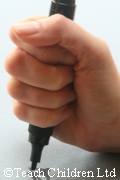
Holds the crayon/pencil in fist (whole hand) like a dagger. They use whole arm movements from the shoulder to mark-make. Due to this whole arm movement they prefer to work on a vertical surface.
Stage 2 - Palmer or digital-pronate grasp
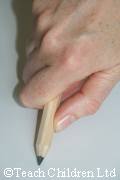
Holds a crayon/pencil with the palm of the hand facing down towards the paper. The crayon/pencil is held by all the fingers and the thumb. The movement comes from the shoulder and elbow. Again due to the way the arm moves a vertical surface is preferred.
Stage 3 - Four finger and thumb grip
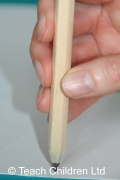
Holding the crayon/pencil between the thumb and four fingers with the crayon/pencil in a nearly vertical, upright position. Movement comes from the elbow and wrist.
Stage 4 - Static quadruped or tripod grip
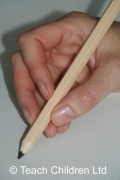
Holding the pencil in very nearly the correct position however the web space is narrower than it would be if held in a mature tripod grip. This means that the movement is coming from the wrist and large finger movements.
Stage 5 - Mature / Dynamic tripod grip
Right-
Handed
Left-
Handed
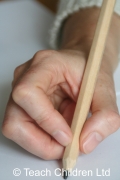
This is traditionally considered the most appropriate handwriting pencil grip for both left and right-handed writers. Holding the pencil between the thumb and index finger with pencil supported on the middle finger. The ring and little fingers are gently curled inwards. This gives an open wide web space which means the movement comes from the fingers.
